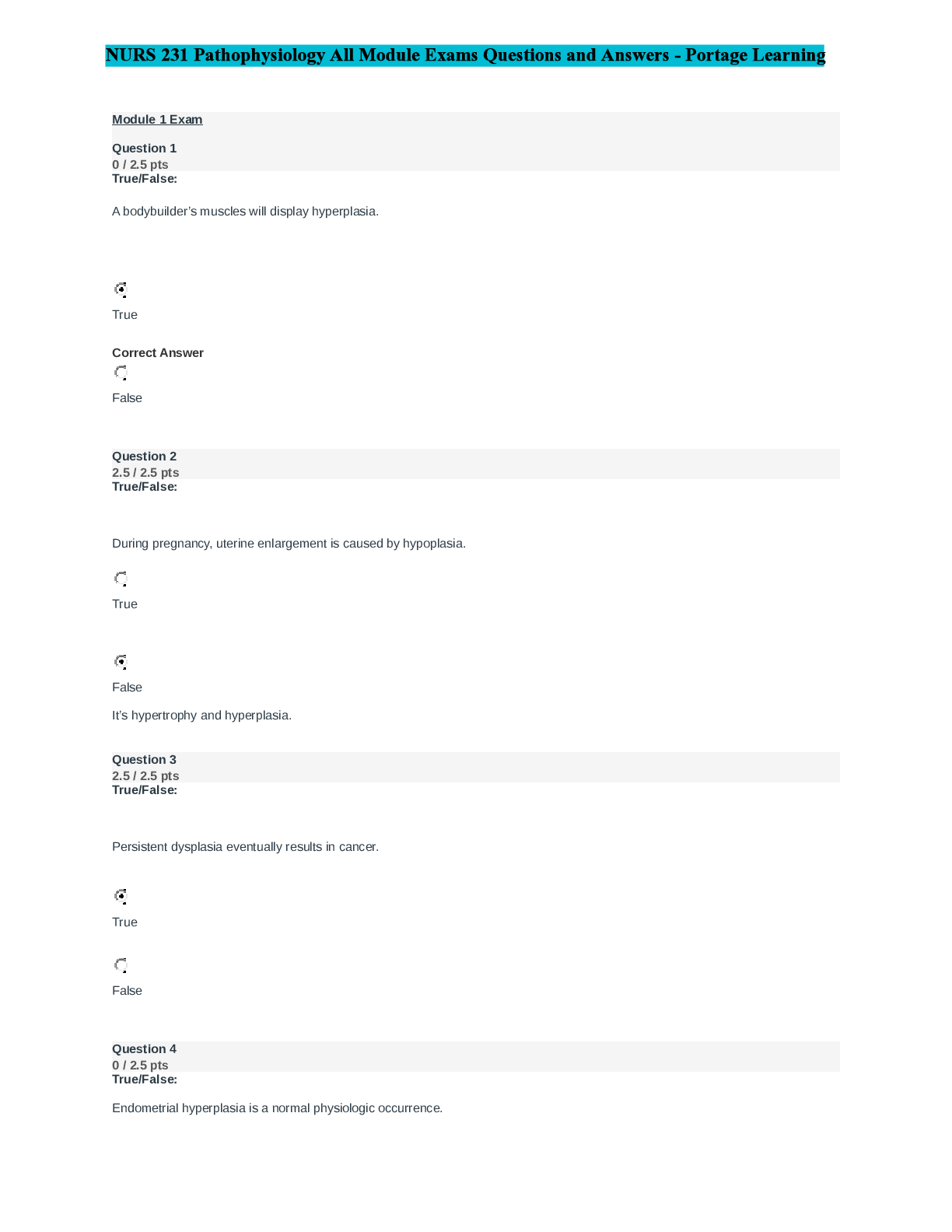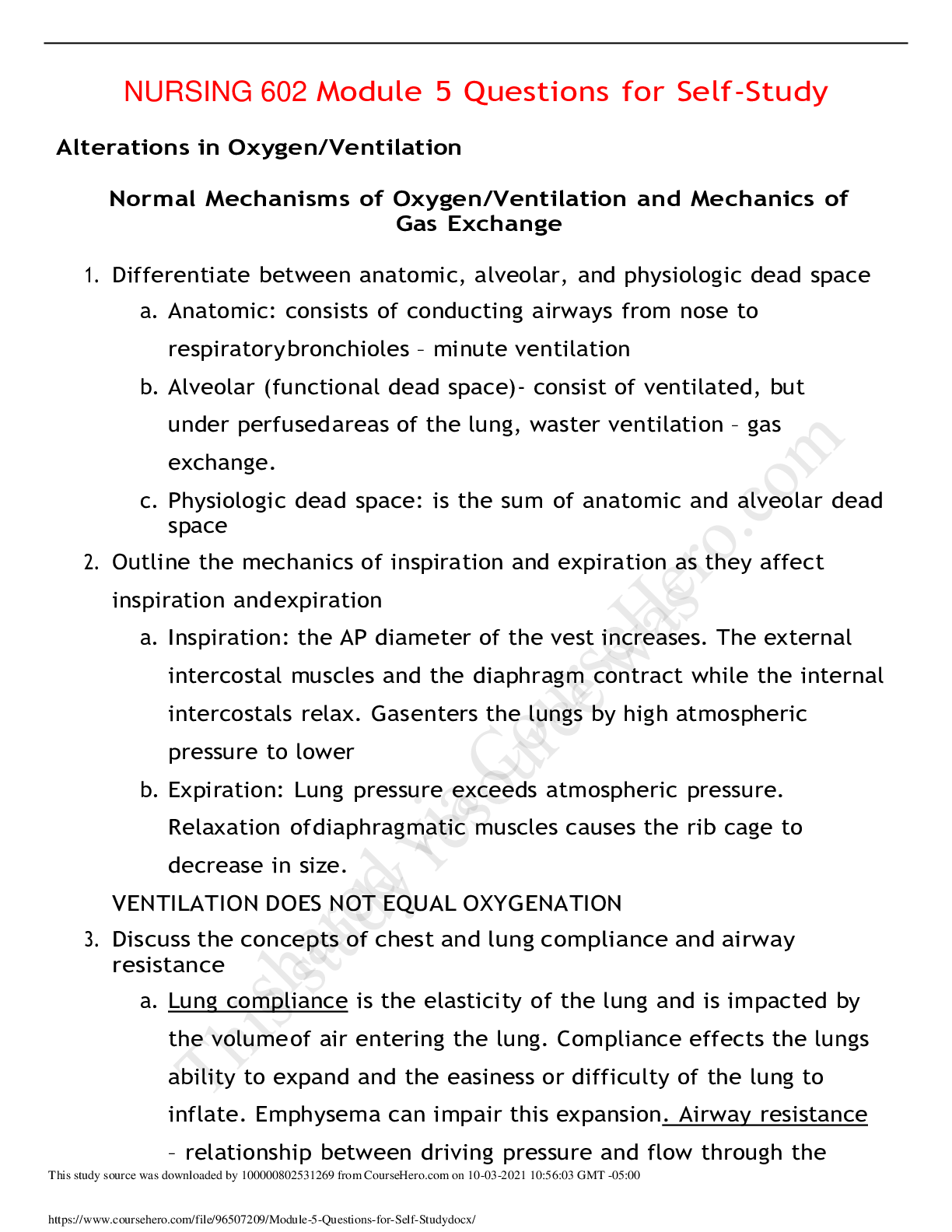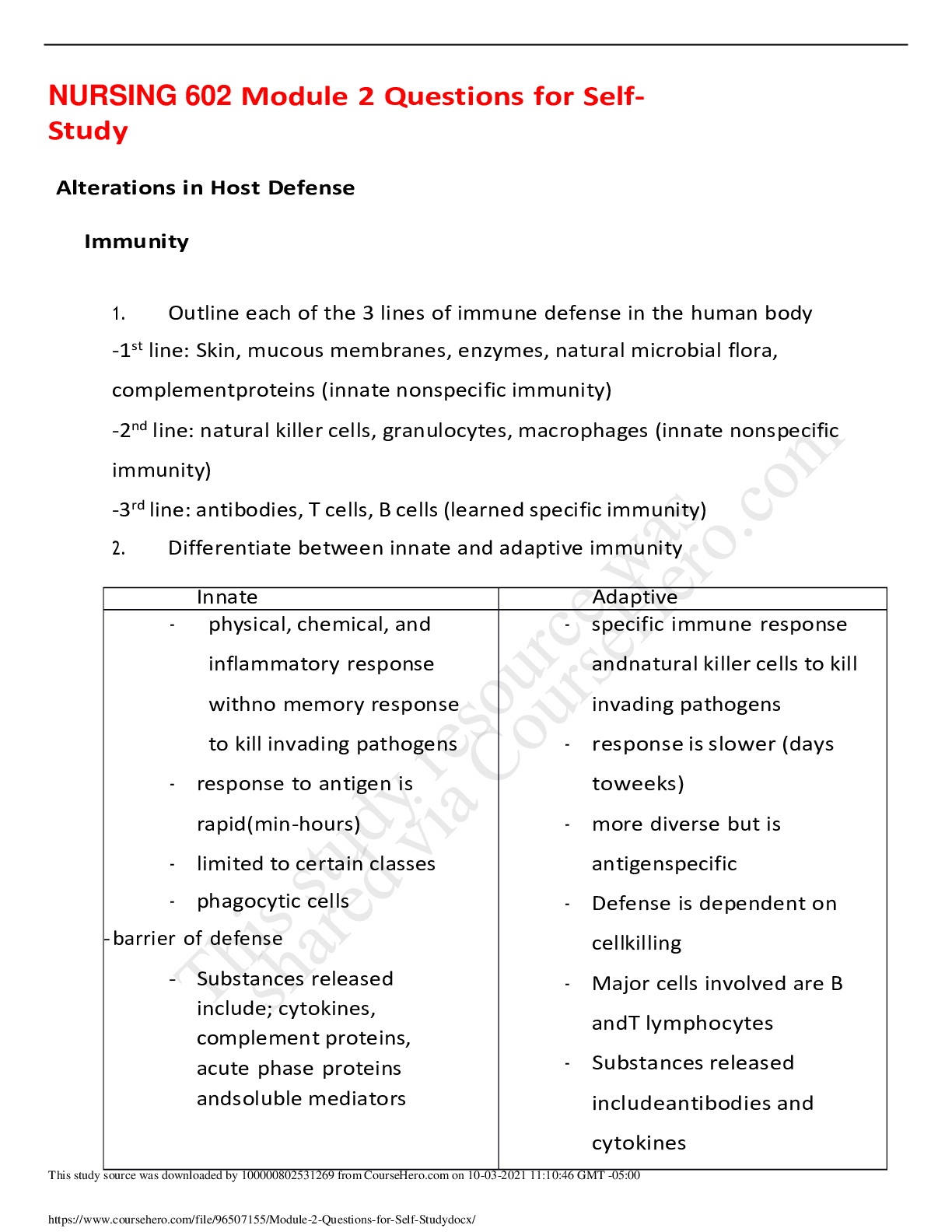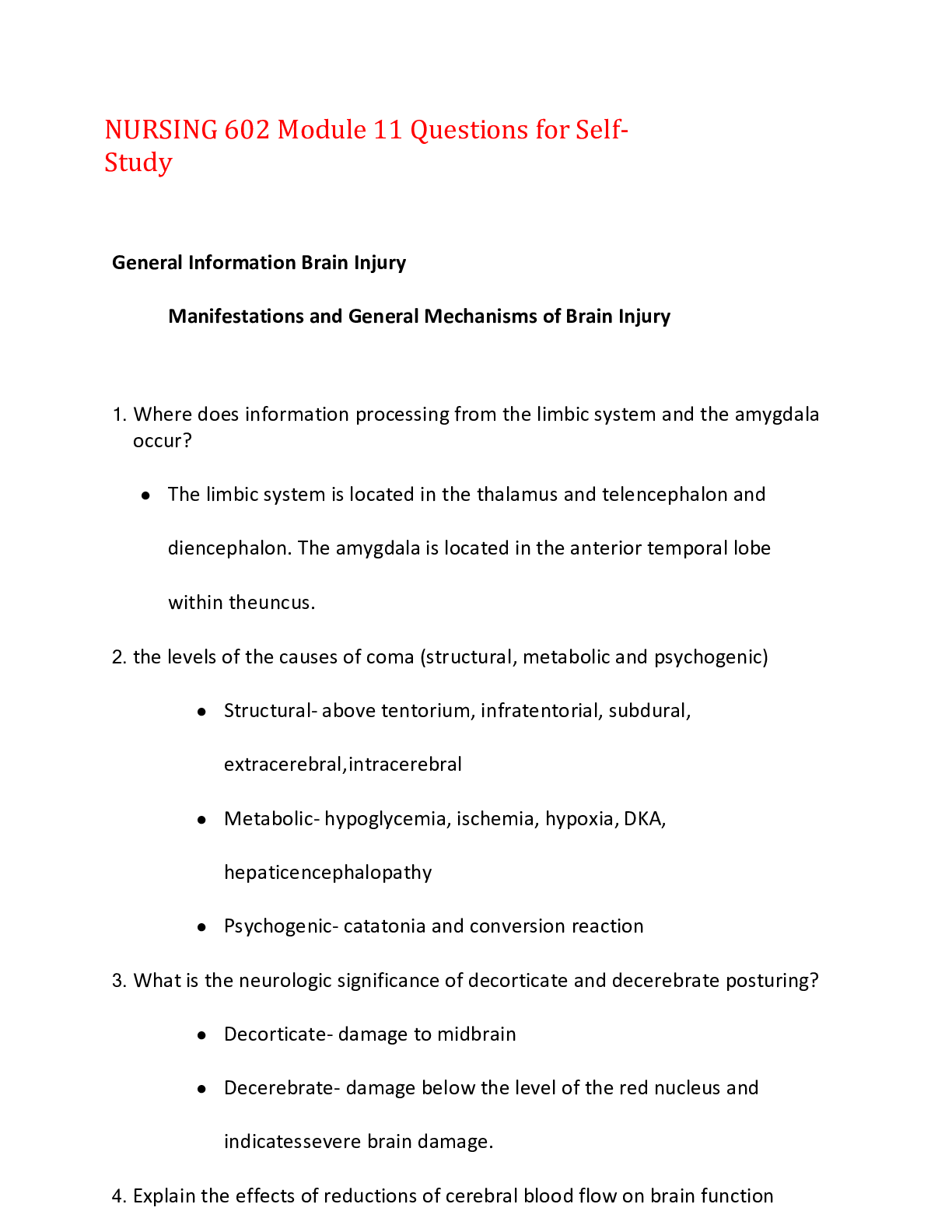NURSING 602 Module 10 Questions for Self-Study,100% CORRECT
Document Content and Description Below
NURSING 602Module 10 Questions for Self-Study Normal Kidney and Colon Physiology 1. Outline the normal controls of renal blood flow, glomerular filtration and renin secretion a. Renal blood flo... w- when blood pressure drops, the smooth muscle cells relax to lower resistance, allowing a continued even flow of blood. When blood pressure increases, smooth muscle cells in the wall of the arteriole are stretched and respond by contracting to resist the pressure, resulting in little chance in flow. This is the myogenic mechanism. b. Glomerular filtration- the tubuloglomerular feedback includes the JGA and a paracrine signaling mechanism that uses ATP, adenosine, and nitric oxide. Specialized macula densa cells in this segment of the tubule respond to changes in the fluid flow rate and Na+ concentration. As GFR increases, there is less time for the NaCl to be reabsorbed I the PCT, resulting in higher osmolarity in the filtrate. ATP and adenosine act locally as paracrine factors to stimulate the myogenic juxtaglomerular cells of the afferent arteriole to constriction, slowing blood flow. Decreased GFR is opposite. c. Renin Secretion- when blood volume or sodium levels in the body are low, or blood potassium is high, cells in the kidney release the enzyme, renin. Renin converts angiotensinogen (produced by the liver) to the hormone angiotensin I. Angiotensin II causes blood vessels to constrict and blood pressure to increase. Angiotensin II stimulates the release of the hormone aldosterone in the adrenal glands, which causes the renal tubules to retain sodium and water and excrete potassium. Together, angiotensin II and aldosterone work to raise blood volume, blood pressure and sodium levels in the blood to restore the balance of sodium, potassium, and fluids. 2. What is the role of goblet cells in mucous in the large intestine? a. The main role of goblet cells in the mucous are to produce mucus to protect and lubricate the surface of the intestines. Selected Disorders of Kidney Function Common Clinical Presentation/Features of Renal Disorders 1. Describe the common clinical manifestations/features of kidney disorders a. Urea excretion b. Sodium, potassium balance c. Water balance d. Progressive elevation of blood urea nitrogen and creatinine 1. Identify the risk factors of pyelonephritis a. Pregnancy b. Diabetes mellitus c. Anatomic abnormalities of the urinary tract (vesicoureteral reflux in children) d. Urinary tract obstruction 2. Outline the pathophysiology of pyelonephritis and the role of inflammation a. Acute ascending infection is the most common or blood borne infection b. Bacteria bind to the kidney epithelial cell receptors which initiates an inflammatory response to the bacteria. E. coli is the most common organism that binds to epithelial cells. 3. Describe the clinical presentation/features of acute and chronic pyelonephritis a. Sudden onset of fever, chills, and CAV b. Dysuria, urgency, and frequency c. Flank pain Nephrolithiasis 1. Outline the pathophysiology of nephrolithiasis a. Alterations in the solubility of a range of constituents in the urine (predominantly calcium) with crystal formation. Formation of Randall’s plaques (made up calcium phosphate). The crystals adhere to the urinary tract endothelium causing it to erode and form a nidus for calcium oxalate deposition. b. A pH of the urine less than 7.2 can result in calcium oxalate and is also associated with formation of uric acid calculi. 2. Describe the clinical presentation/features of nephrolithiasis a. Pain due to distention of the ureter, renal pelvis, or capsule b. Hematuria c. Anuria or azotemia 3. Describe the complications of renal calculi a. Hydronephrosis b. Infection or abscess formation c. Hypertension from increased renin production die to obstruction d. Renal damage due to repeated formation of kidney stones e. Permanent renal damage if complete obstruction of ureter Glomerulonephritis and Nephrotic Syndrome 1. Discuss the pathophysiology of glomerulonephritis. How does acute glomerulonephritis differ from chronic glomerulonephritis? a. Acute glomerulonephritis- due to inflammation of the glomerulus after an infectious disease; streptococcal infection, bacterial endocarditis, hep b, mumps, measles, varicella, Guillain-Barre syndrome b. Chronic- reduced nephron mass leads to hypertrophy and hyper infiltration in remain nephrons and intraglomerular hypertension. 2. Explain the pathogenic mechanisms of glomerular injury and acute postinfectious glomerulonephritis (PIGN) a. Glomerular injury- Goodpasture syndrome, administration of drugs, antibody formation against both pulmonary and glomerular basement membranes leading to hemorrhage, idiopathic crescentic glomerulonephritis b. PIGN- intraglomerular inflammation and cellular proliferation resulting from immunological events triggered by a bacteria, virus, or protozoa infections. 3. Describe the effects of glomerular damage on the functions of the nephron a. The reduction of GFR leads to retention of uremic toxins 4. Explain how the pathophysiology of nephrotic syndrome causes the clinical presentation/features a. Profound decreased oncotic pressure due to loss of serum proteins in the urine b. Signs of intravascular volume depletion c. Edema d. Hypercoagulability due to antithrombin deficiency, hyperfibrinogenemia, and hyperlipidemia e. Vitamin D deficiency and secondary hyperparathyroidism f. Altered thyroid function due to reduced levels of thyroxine-binding globulin 5. What are the common symptoms of glomerulonephritis? Why do they occur (e.g. edema)? a. Edema – due to fluid retention and excessive loss of albumin which causes capillary leakage and edema b. Malaise c. Hematuria (leakage across glomerular capillary walls) d. Foamy urine e. Oliguria Acute and Chronic Renal Disease Acute Renal Injury 1. Differentiate between the causes of prerenal, intrarenal, and post-renal kidney failure a. Prerenal- due to loss of renal perfusion; severe drop in blood pressure with shock or interruption of the blood flow to the kidneys (injury or illness) b. Intrarenal- direct damage to the kidney by inflammation, toxins, drugs, infection, and reduced blood supply c. Post-renal kidney failure- a sudden obstruction of urine flow due to enlarged prostate, renal calculi, or bladder tumor 2. Explain the pathophysiology of acute tubular necrosis (ATN) a. Ischemia is the most common cause prolonged hypotension or shock. Blood flow is redirected from the cortex to the kidney medulla, this causes renal tubular damage. Damaged cells in the loop of henle initiate cellular necrosis and apoptosis. 3. Outline the 3 phases of ATN relative to the effect on clinical presentation/features a. Phase I- Prodromal Stage: urinary output may be normal or minimally low. The BUN and creatinine are begging to be increased. b. Phase II- The Oliguric Phase: oliguria or anuria is present, weight gain, edema, hyperkalemia, uremia, metabolic acidosis, anorexia, N/V, confusion c. Phase III- post oliguric phase: Fluid volume deficits (1-5 liters / day), low circulating volume, tubular dysfunction (depletion of electrolytes), BUN and creatinine may remain elevated, renal perfusion improves but normal function is delayed to normalcy Chronic Kidney Disease (CKD) 1. Identify the physiologic definition and risk factors of CKD a. Sustained abnormal kidney function or kidney damage for more than 3 months. It also may be defined as a GFR less than 60ml for 3 months without overt evidence of kidney damage. b. Acute tubular necrosis showing no improvement beyond oliguric phase c. Neoplasms d. Infections- pyelonephritis e. Glomerulonephritis f. Dm, hypertensin, lover failure, goodpasture syndrome 2. Describe the pathophysiology of CKD a. Damage of nephrons to the kidney from renal injury or ischemia produces loss of nephrons which can lead to scarring. Reuction in tubular flow increase the vasoconstrictor angiotensin II. Protein leaks from the blood into the glomerular filtrate. 3. Outline the 5 stages of CKD progression a. Stage I- kidney damage with normal or increased GFR (>90) b. Stage II- mildly decreased GFR (60-89) c. Stage III- moderately decreased GFR (45-59) d. Stage IV- severely decreased (15-29) e. Stage V- end-stage renal disease (GFR less than 15) Complications of Chronic Renal Disease 1. Identify the common complications of CKD and the consequences of each complication a. Hypertension & Cardiovascular Disease- vasocontriction increases afterload and puts a strain on MI which intensifies oxygen demand and can lead to heart failure b. Uremic Syndrome- renal function leads to retention of metabolic wastes and leads to motor and sensory neuropathies c. Metabolic Acidosis- increased exchange of potassium and inability to secrete hydrogen ions and produce bicarbonate d. Electrolyte Imbalance- retention of potassium, phosphorus and magnesium in the blood. Leads to hyperkalemia and cardiac arrhythmias e. Mineral & Bone Disorders- inability to excrete phosphorus leading to hypocalcemia and the development of secondary hypothyroidism and osteoporosis. f. Malnutrition- loss of muscle and visceral protein stores g. Anemia- decreased erythropoietin production reduces production of RBCs leading to cardiorenal anemia 2. Describe the clinical presentation/features of CKD a. Lethargy b. Uremic frost c. Anorexia d. N/V e. Anemia f. Epistaxis g. Amenorrhea, infertility h. Myopathy Disorders of Large Intestine Functions Diarrhea 1. Outline the general manifestation of intestinal disorders a. Abdominal pain, intestinal gas and abdominal discomfort, alteration in bowel patters 2. Differentiate among osmotic, secretory, exudative diarrhea and diarrhea associated with motility disorders a. Osmotic- malabsorption of lactulose and magnesium sulfate which increases waste in the colon and cannot be absorbed so stool liquidity increases. b. Secretory- enterotoxins and fatty acids can stimulate intestinal cell secretions c. Exudative diarrhea- is an inflammatory disorder that exudates mucus, blood or protein IBD 1. Describe the characteristic manifestations of inflammatory bowel disease a. Mucosal ulceration of colon and inflammation of the GI tract 2. Differentiate between pathophysiology and the bowel changes associated with ulcerative colitis, and Crohn’s disease a. UC- begins in the anorectal area, necrotic lesions in the colon form. Crypt epithelial injury ultimately is associated with leukocyte infiltration b. Crohn’s Disease- damage results from blockage of the lymphoid and lymphatic structures in the intestine. Engorgement and ulceration of the mucosa are followed by deep layers in the bowel wall 3. Describe the clinical manifestations/features of ulcerative colitis and Crohn’s disease a. UC- weight loss, fatigue, abdominal pain, diarrhea, rectal bleeding, megacolon b. Crohn’s- diarrhea, fever, abdominal pain, leukocytosis, malnourishment Colon Polyps and Carcinoma 1. Outline the common characteristics of tumors of the ascending, descending and sigmoid colon a. Ascending & descending- massive gas distention, abdominal fullness, ribbon- like stool, presence of blood or mucus in stools b. Sigmoid colon- change in bowel habits, an urgent need to defecate, alternating constipation to diarrhea [Show More]
Last updated: 1 year ago
Preview 1 out of 14 pages

Buy this document to get the full access instantly
Instant Download Access after purchase
Add to cartInstant download
We Accept:

Reviews( 0 )
$13.00
Document information
Connected school, study & course
About the document
Uploaded On
Oct 03, 2021
Number of pages
14
Written in
Additional information
This document has been written for:
Uploaded
Oct 03, 2021
Downloads
0
Views
24























